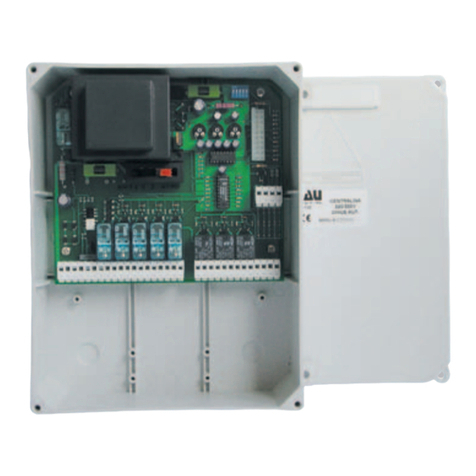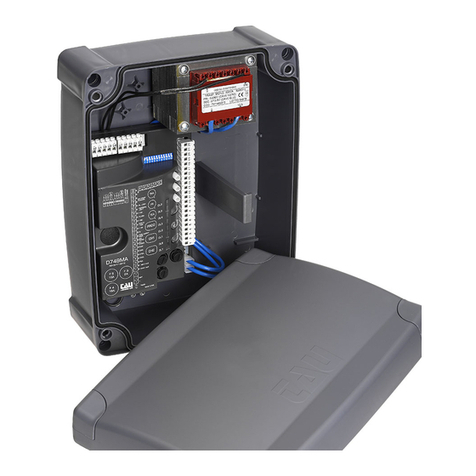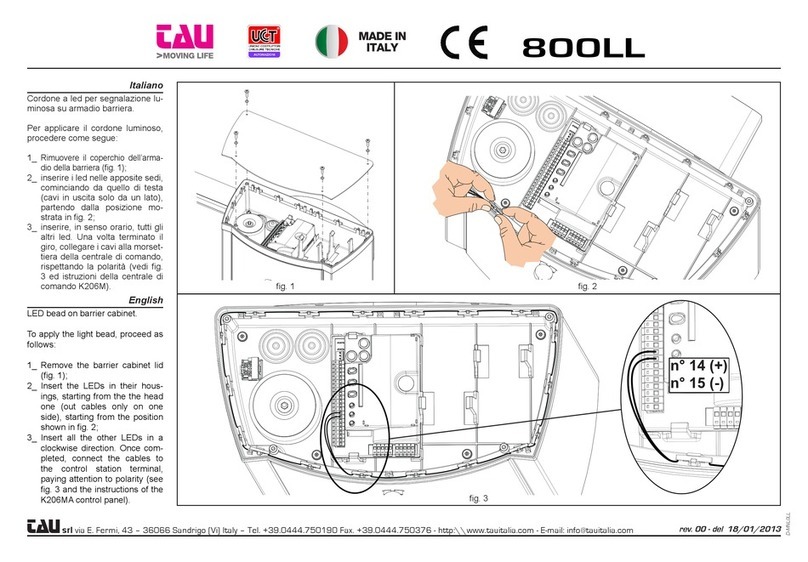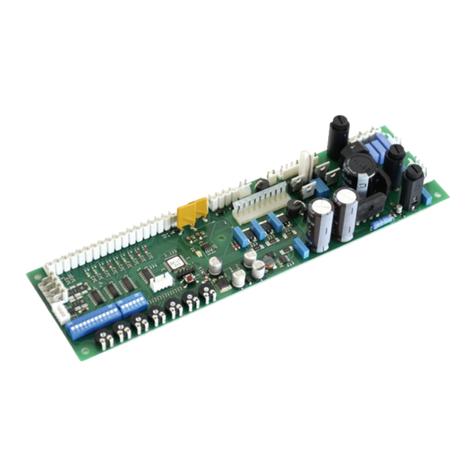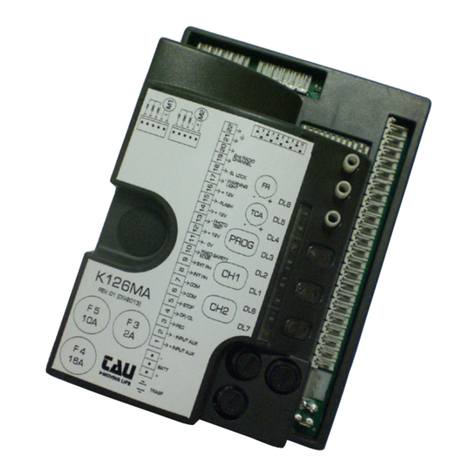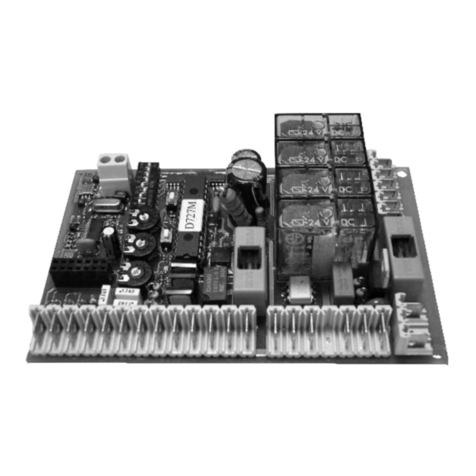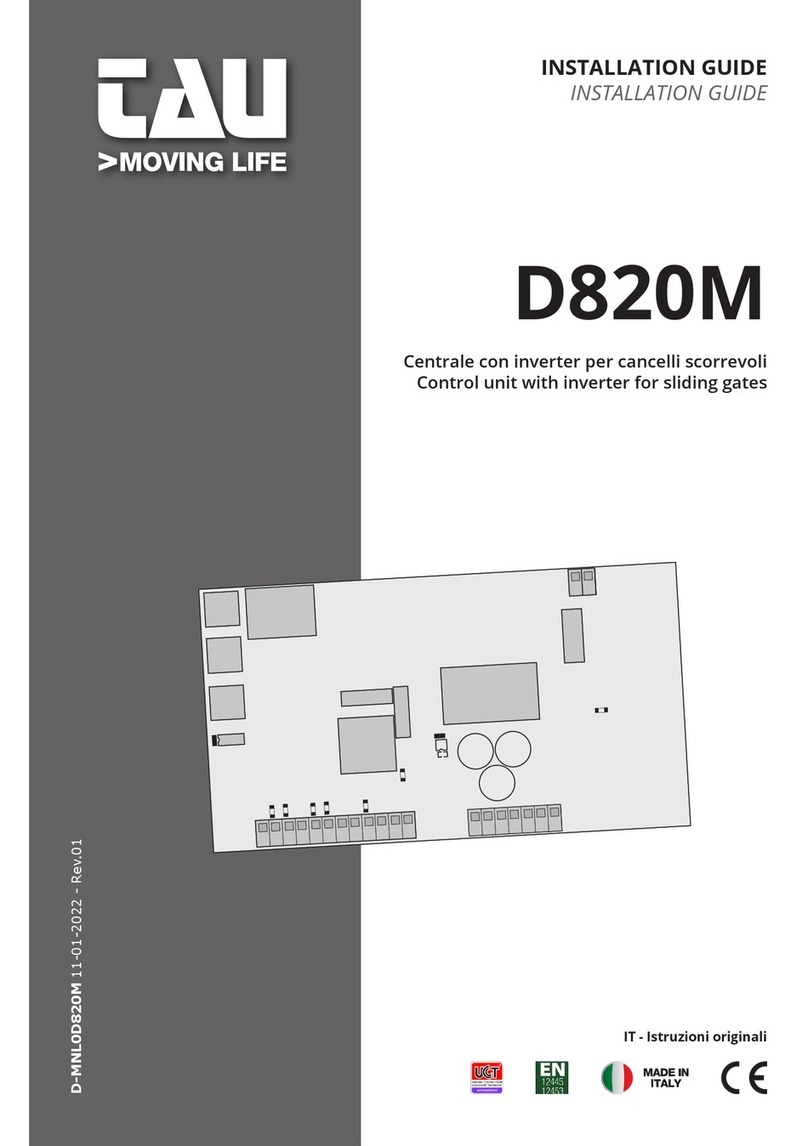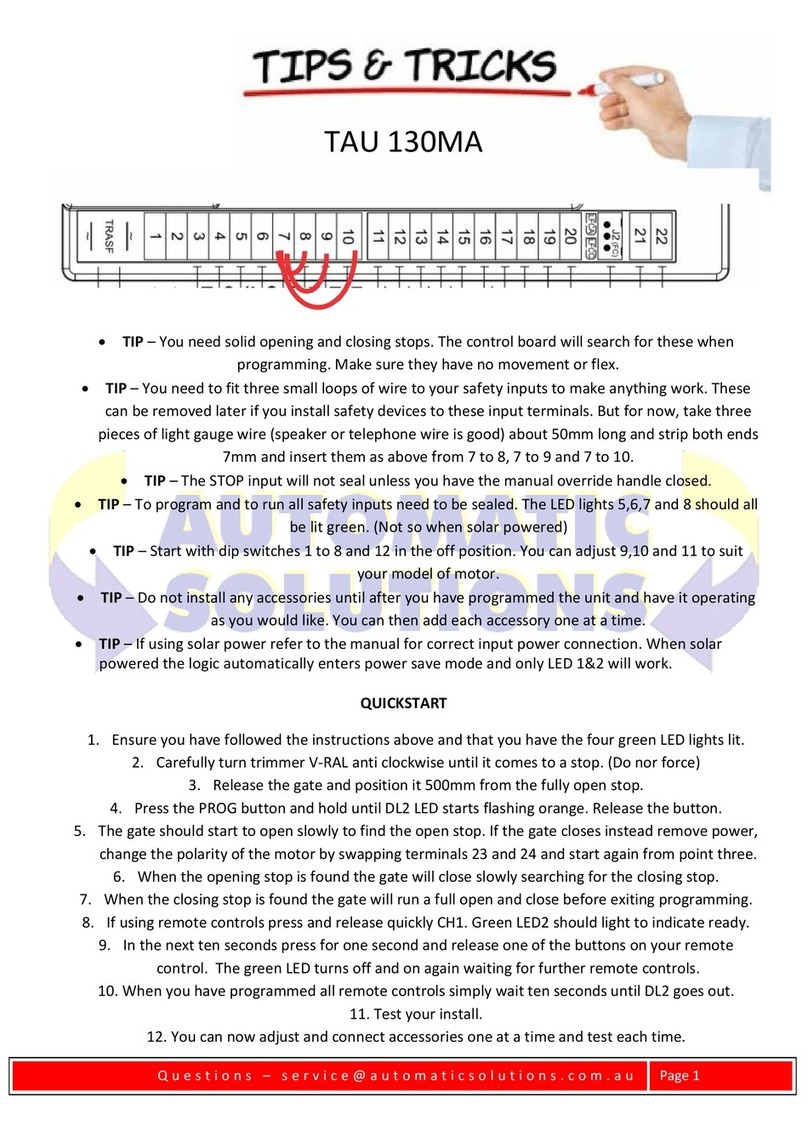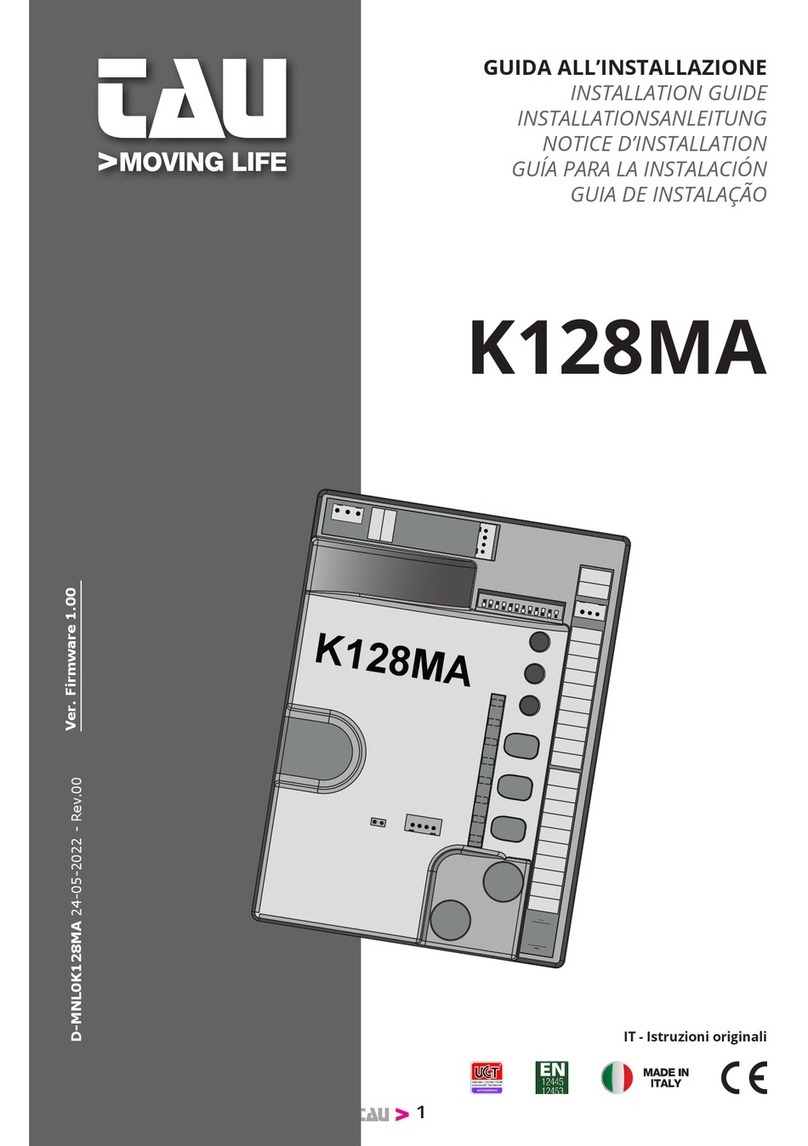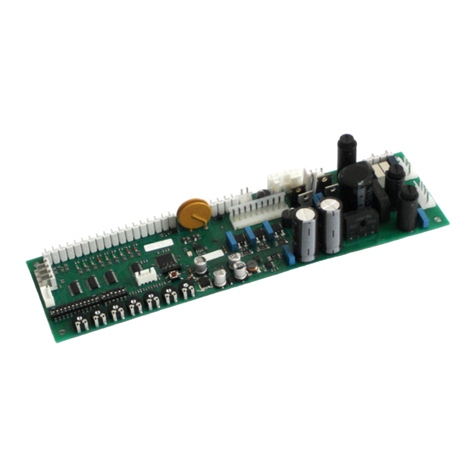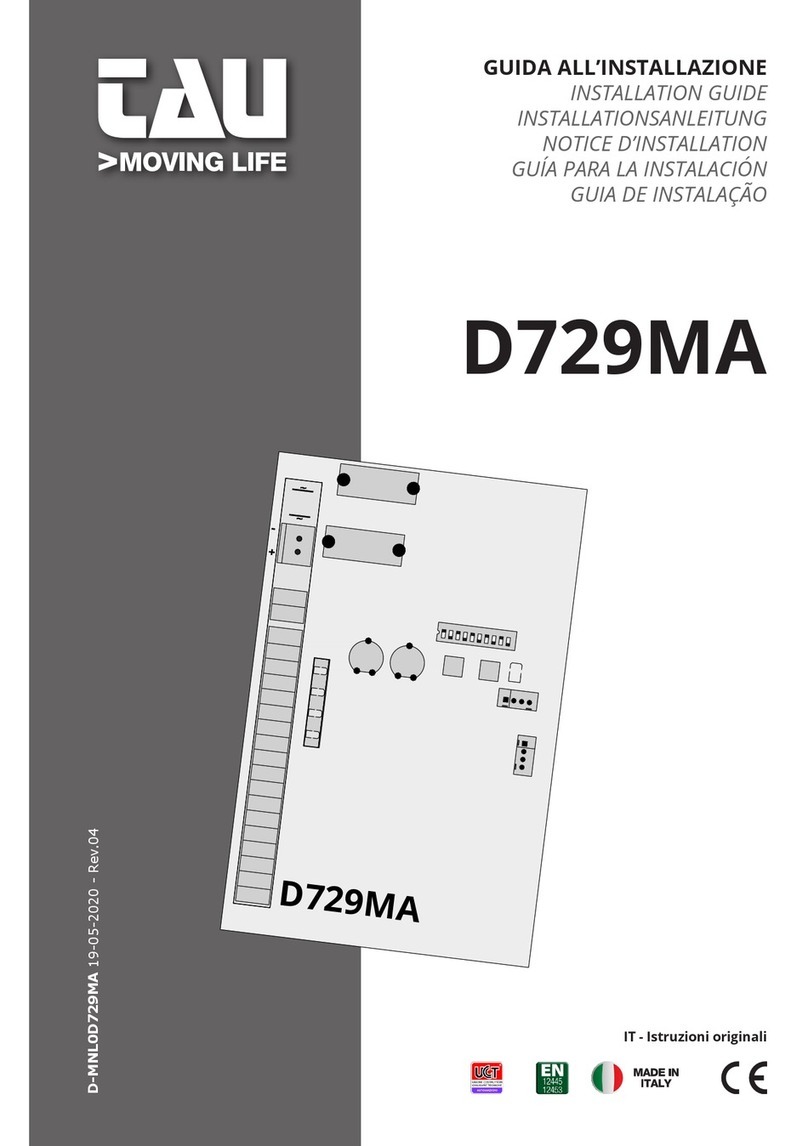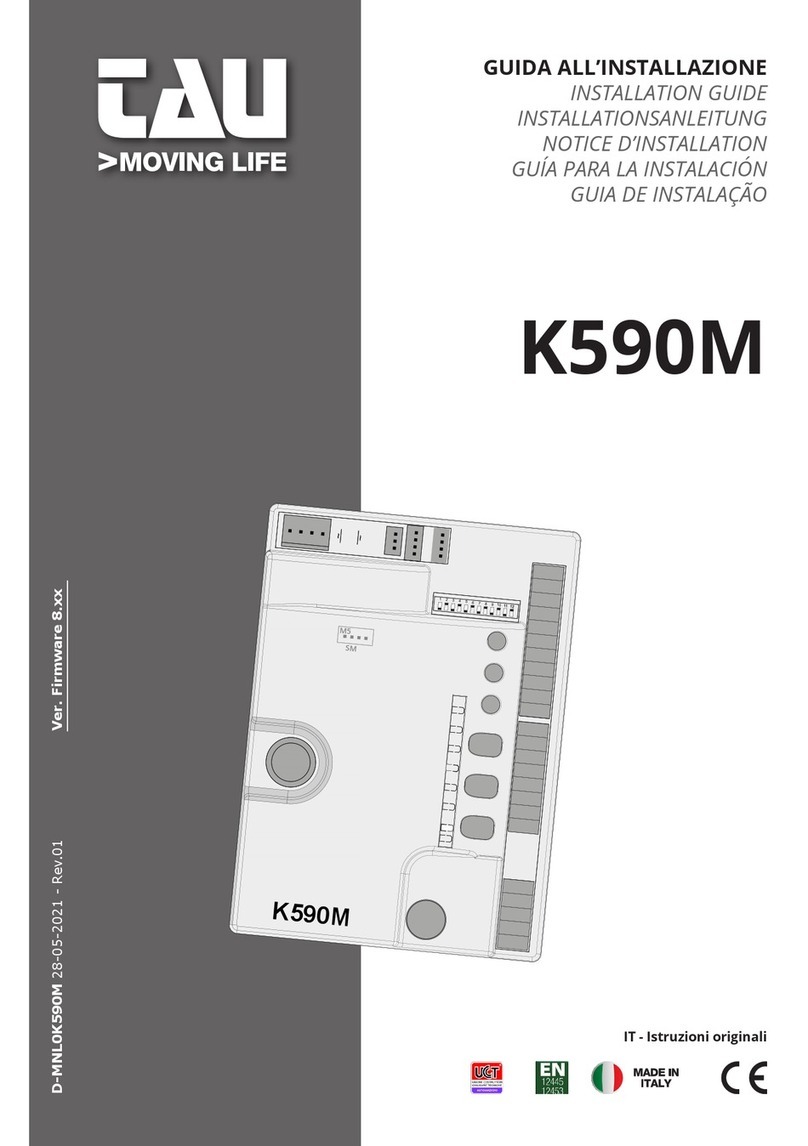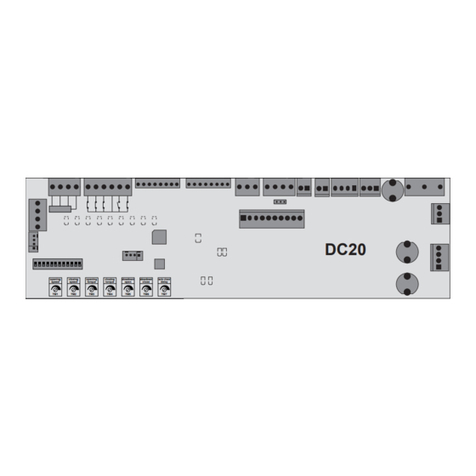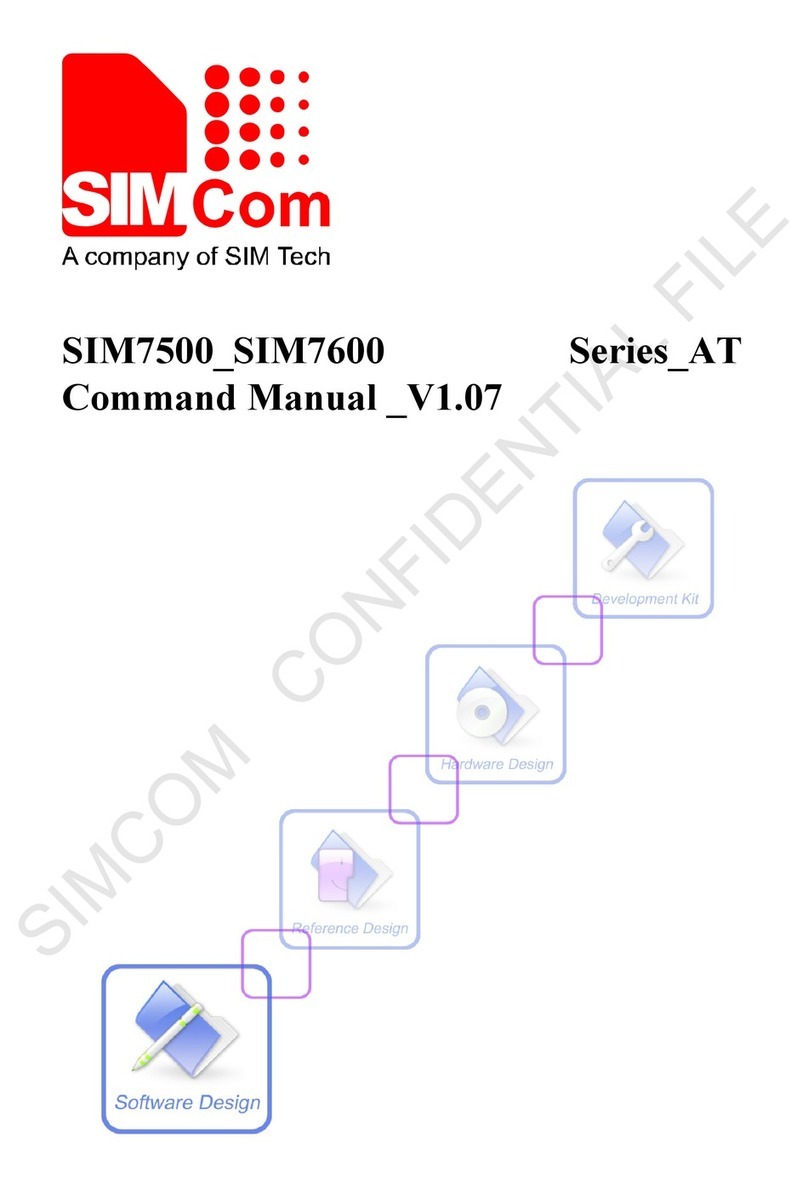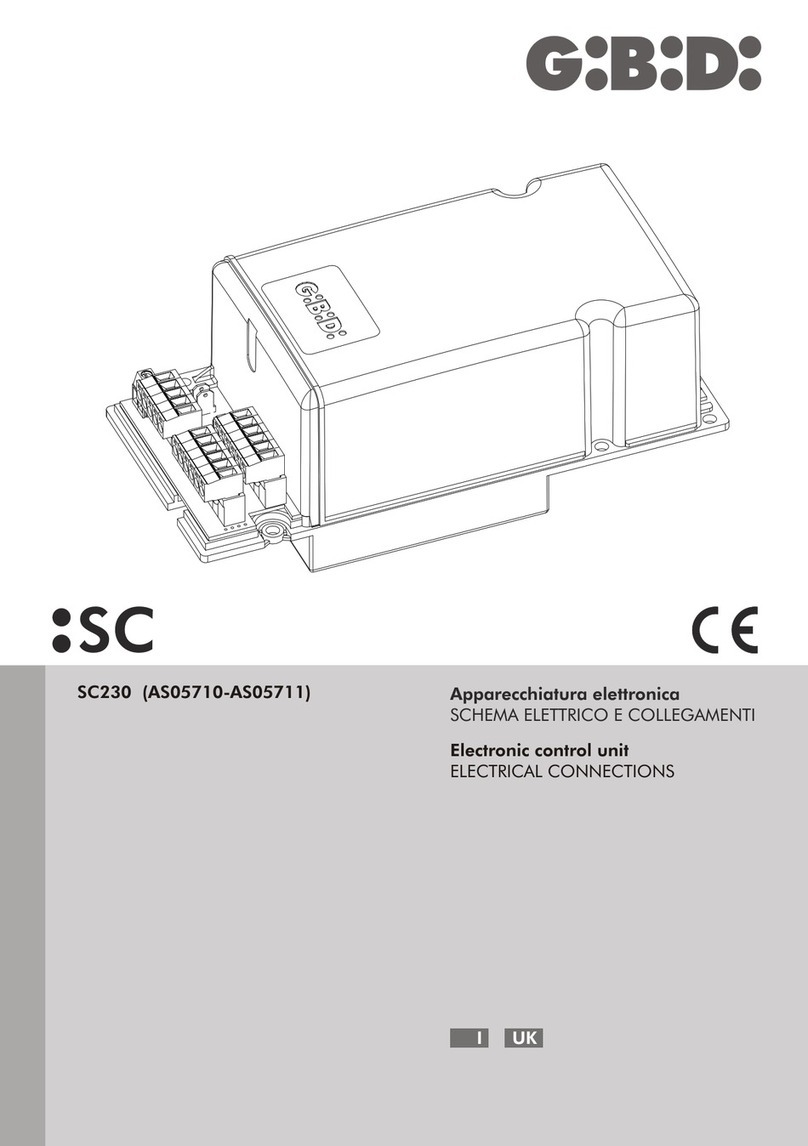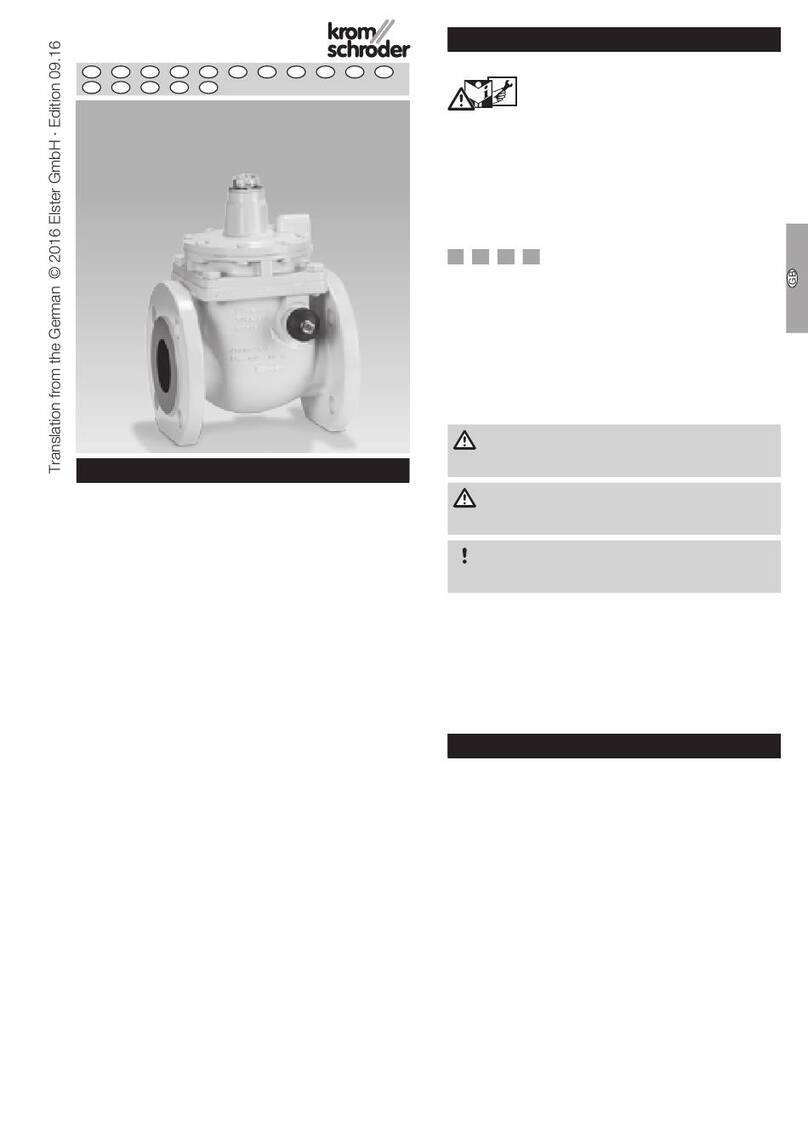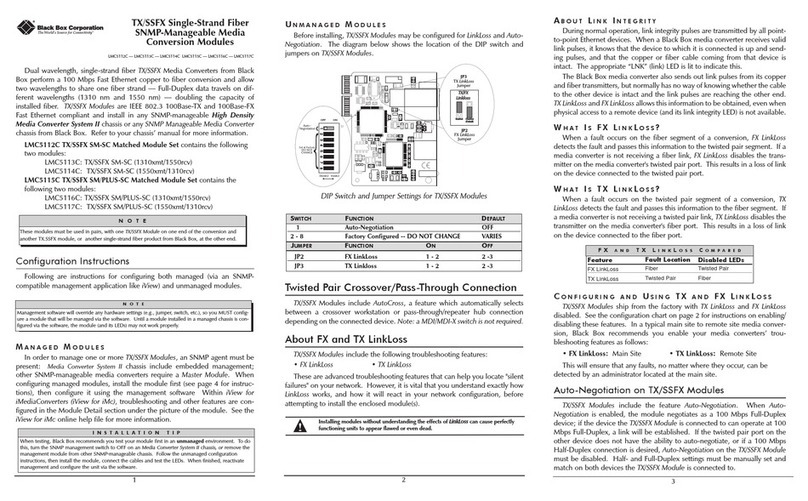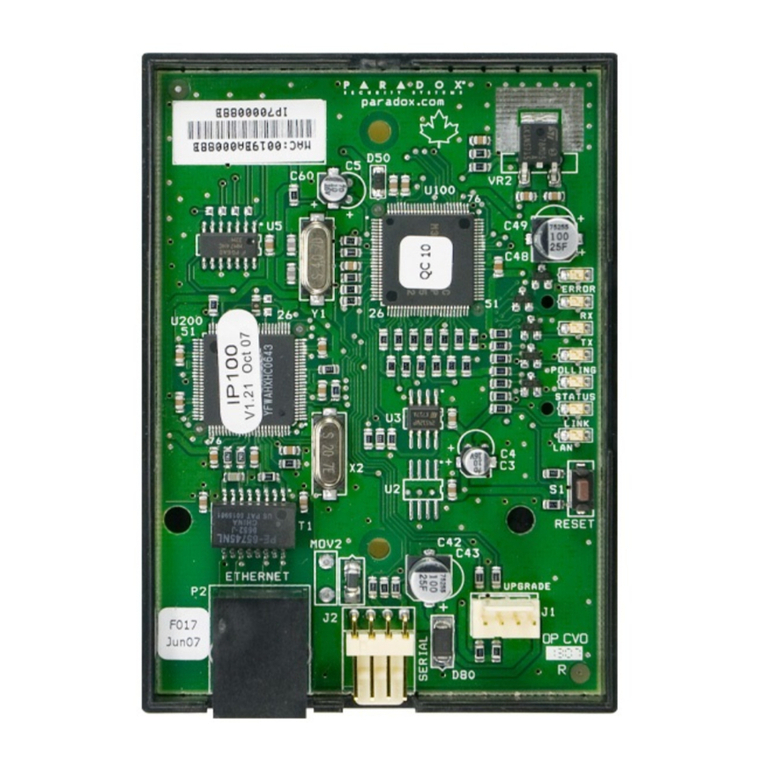tau K996MA User manual

GUIDA ALL’INSTALLAZIONE
INSTALLATION GUIDE
INSTALLATIONSANLEITUNG
NOTICE D’INSTALLATION
GUÍA PARA LA INSTALACIÓN
GUIA DE INSTALAÇÃO
IT - Istruzioni originali
K996MA
K996M
D-MNL0K996M 18-03-2020 - Rev.13

2
SCHEMA CABLAGGIO K996M / K996M WIRING DIAGRAM
SCHALTPLAN DER K996M / SCHÉMA CÂBLAGE K996M
ESQUEMA DEL CABLEADO K996M
Op/Cl =Open/Close
M = Motor
FS1
TRANSFORMER
POWER SUPPLY
230V 50Hz 10%
FS2
FUSE

3
Op/Cl =Open/Close
M = Motor
FS1
TRANSFORMER
POWER SUPPLY
230V 50Hz 10%
FS2
FUSE

4
COLLEGAMENTO SCHEDA CARICA BATTERIA (OPZIONALE)
BATTERY CHARGER BOARD CONNECTION (OPTIONAL)
ANSCHLÜSSE DER BATTERIELADEKARTE (OPTIONAL)
CONNEXION DE LA CARTE CHARGEUR DE BATTERIE (EN OPTION)
CONEXION DE LA TARJETA CARGA BATERÍA (OPCIONAL)
F 8A - 5x20
Fusibile rapido 8 Ah 5x20 a protezione della batteria 12 V 7,2 Ah
F 8A - 5x20
8 Ah 5x20 fast-acting fuse for protection of 12 V 7.2 Ah battery
F 8A - 5x20
Schnellsicherung 8 Ah 5x20 zum Schutz der Batterie 12 V 7,2 Ah
F 8A - 5x20
Fusible rapide 8 Ah 5x20 pour la protection de la batterie 12 V 7,2 Ah
F 8A - 5x20
Fusible rápido 8 Ah 5x20 como protección de la batería 12 V 7,2 Ah
5 4 3 2 1 1Rosso / Red / Rot / Rouge / Rojo
2Nero / Black / Schwarz / Noir / Negro
3Bianco / White / Weiß / Blanc / Blanco
4Marrone / Brown / Braun / Marron / Marrón
5Non utilizz. / Not used / Nicht verwendet / Non utilisé
/ No utilizado

5
AVVERTENZE
Il presente manuale è destinato solamente al personale tecnico qualicato per l’installazione. Nessuna
informazione contenuta nel presente fascicolo può essere considerata d’interesse per l’utilizzatore nale.
Questo manuale è allegato alla centralina K996M, non deve pertanto essere utilizzato per prodotti diversi!
Avvertenze importanti: Togliere l’alimentazione di rete alla scheda prima di accedervi.
La centralina K996M è destinata al comando di un motoriduttore elettromeccanico per l’automazione di
cancelli, porte e portoni.
Ogni altro uso è improprio e, quindi, vietato dalle normative vigenti.
È nostro dovere ricordare che l’automazione che state per eseguire, è classicata come “costruzione di
una macchina” e quindi ricade nel campo di applicazione della direttiva europea 2006/42/CE (Direttiva
Macchine).
Questa, nei punti essenziali, prevede che:
- l’installazione deve essere eseguita solo da personale qualicato ed esperto;
- chi esegue l’installazione dovrà preventivamente eseguire “l’analisi dei rischi” della macchina;
- l’installazione dovrà essere fatta a “regola d’arte”, applicando cioè le norme;
- inne dovrà essere rilasciata al proprietario della macchina la”dichiarazione di conformità”.
Risulta chiaro quindi che l’installazione ed eventuali interventi di manutenzione devono essere eettuati
solo da personale professionalmente qualicato, in conformità a quanto previsto dalle leggi, norme o di-
rettive vigenti.
Nella progettazione delle proprie apparecchiture, TAU rispetta le normative applicabili al prodotto (vedere
la dichiarazione di conformità allegata); è fondamentale che anche l’installatore, nel realizzare gli impianti,
prosegua nel rispetto scrupoloso delle norme.
Personale non qualicato o non a conoscenza delle normative applicabili alla categoria dei “cancelli e porte
automatiche” deve assolutamente astenersi dall’eseguire installazioni ed impianti.
Chi non rispetta le normative è responsabile dei danni che l’impianto potrà causare!
Si consiglia di leggere attentamente tutte le istruzioni prima di procedere con l’installazione.
INSTALLAZIONE
Prima di procedere assicurarsi del buon funzionamento della parte meccanica. Vericare inol-
tre che il gruppo motoriduttore sia stato installato correttamente seguendo le relative istru-
zioni. Eseguiti questi controlli, assicurarsi che il motoriduttore non abbia un assorbimento du-
rante il movimento superiore a 3 A (per un corretto funzionamento del quadro di comando).
L’INSTALLAZIONE DELL’APPARECCHIATURA DEVE ESSERE EFFETTUATA “A REGOLA D’ARTE” DA PERSO-
NALE QUALIFICATO COME DISPOSTO DAL D.M. 37/08.
NB : si ricorda l’obbligo di mettere a massa l’impianto nonché di rispettare le normative sulla
sicurezza in vigore in ciascun paese.
LA NON OSSERVANZA DELLE SOPRAELENCATE ISTRUZIONI PUÒ PREGIUDICARE IL BUON FUNZIO-
NAMENTO DELL’APPARECCHIATURA E CREARE PERICOLO PER LE PERSONE, PERTANTO LA “CASA CO-
STRUTTRICE” DECLINA OGNI RESPONSABILITÀ PER EVENTUALI MAL FUNZIONAMENTI E DANNI DOVUTI
ALLA LORO INOSSERVANZA.
1. SCHEDA COMANDO PER UNO O DUE MOTORI 12V DC PER PORTE BASCULANTI
• LOGICA CON MICROPROCESSORE
• STATO DEGLI INGRESSI VISUALIZZATO DA LEDs
• PROTEZIONE INGRESSO LINEA CON FUSIBILE
• CIRCUITO DI LAMPEGGIO INCORPORATO
• RADIO RICEVITORE 433,92 MHz INTEGRATO
• SENSORE AD ENCODER PER RILEVAMENTO OSTACOLI ED AUTOAPPRENDIMENTO DELLA CORSA
• DIAGNOSTICA DEL DIFETTO FUNZIONE VISUALIZZATO DA LED
ATTENZIONE:
ITALIANO

6
- non utilizzare cavi unilari (a conduttore unico), es. quelli citofonici, al ne di evitare inter-
ruzioni sulla linea e falsi contatti;
- non riutilizzare vecchi cavi preesistenti;
- utilizzare il cavo TAU M-30000CC50 o un altro cavo equivalente.
- In caso di lunghi tratti di cavi ( > 20 m) per i comandi N.A. / N.C. (es: APRE/CHIUDE, STOP,
PEDONALE, ecc), al ne di evitare malfunzionamenti del cancello si renderà necessario disac-
coppiare i vari comandi mediante RELAYS oppure utilizzando il nostro dispositivo 750T-RELE.
2. COLLAUDO
A collegamento ultimato:
•I Leds verdi devono essere tutti accesi (corrispondono ciascuno ad un ingresso Normalmente
Chiuso). Si spengono solo quando sono interessati i comandi ai quali sono associati.
• Il Led rosso DL5 deve essere spento (corrisponde all’ingresso Normalmente Aperto APRE/
CHIUDE). Si accende solo quando è interessato dal comando cui è associato.
3. CARATTERISTICHE TECNICHE
Alimentazione scheda 13,5V AC - 50 Hz
Potenza max. motore 1 c.c. 50 W - 18V DC
Potenza max. motore 2 c.c. 50 W - 18V DC
Fusibile rapido protezione alimentazione ingresso 13,5V AC (F1 - 5x20) F 16 A
Fusibile rapido protezione motori (F2 - 5x20) F 10 A
Fusibile rapido protezione ausiliari 18V DC (F3 - 5x20) F 3,15 A
Tensione circuiti alimentazione motore 18V DC
Tensione alimentazione circuiti dispositivi ausiliari 18V DC
Tensioni alimentazioni circuiti logici 5V DC
Temperatura di funzionamento -20 °C ÷ +55 °C
4. COLLEGAMENTI ALLA MORSETTIERA
Morsetti Funzione Descrizione
1 - 2 ALIMENTAZIONE
FS1 - FS2: ingresso alimentazione scheda 13,5 Vac - Alimentato dal trasforma-
tore toroidale riposto nell’apposito vano del motore SPIN12Q e protetto da
fusibile (F 6,3A) sull’alimentazione 230 Vac;
3 - 4 MOTORE 1
18V DC uscita alimentazione motore 1 (M1) 18V DC max. 50 W;
5 - 6 MOTORE 2
18V DC uscita alimentazione motore 2 (M2) 18V DC max. 50 W;
7 - 8 ANTENNA Ingresso antenna per RX 433,92 MHz incorporata; 7= Segnale 8= Massa;
9 - 11 APRE/CHIUDE
ingresso pulsante Apre/Chiude contatto N.A. (Normalmente Aperto): per
le modalità d’uso vedi le funzioni dei dip switch nr. 2-4; 9 = Apre/Chiude;
11 = Comune;
10 - 11 STOP
pulsante Stop contatto N.C. (Normalmente Chiuso). Dopo l’arresto, l’ap-
parecchiatura riparte soltanto dopo un comando del pulsante di marcia o
della radiotrasmittente. 10 = Stop; 11 = Comune;
11 - 12 BORDO
SENSIBILE
Ingresso bordo sensibile resistivo (DIP 5=ON); ingresso bordo sensibile -
costa ssa (DIP 5=OFF);
11 = Comune; 12 = Bordo sensibile.
Se non si utilizza nè il bordo sensibile resistivo, nè la costa ssa, porre il
DIP 5 in OFF e cortocircuitare i morsetti 11 e 12;
ITALIANO

7
13 - 14 LUCE DI
CORTESIA
uscita luce di cortesia ausiliaria 18 Vdc max. 15 W
(13 = POSITIVO - 14 = NEGATIVO);
15 - 16 LAMPEGGIANTE uscita 18 Vdc max. 20 W alimentazione lampeggiante (15 = POSITIVO - 16 = NE-
GATIVO), lampeggio fornito dalla centrale, veloce in chiusura e lento in apertura;
17 - 18 AUX 18V DC uscita ausiliari 18 Vdc max. 15 W (17 = POSITIVO - 18 = NEGATIVO) per
fotocellule, ricevitori, etc...;
M3 ENCODER
PIN1 GND - Negativo (BLU)
PIN2 +5V - Positivo (MARRONE)
PIN3 ENC - Segnale ENCODER (BIANCO)
M4 PASSO-PASSO
STOP
PIN1 Comune
PIN2 Ingresso pulsante PASSO PASSO
PIN3 Ingresso pulsante STOP
PIN4 Comune
IMPORTANTE:
• non alimentare relè ausiliari (morsetti 17-18) onde evitare di pregiudicare il buon funziona-
mento della centrale di comando;
• non collegare in prossimità della centrale di comando degli alimentatori switching o appa-
recchiature similari che potrebbero essere fonte di disturbi;
5. PROCEDURA DI MEMORIZZAZIONE
ATTENZIONE: Dopo aver alimentato il quadro di comando attendere 2 sec. prima di iniziare a
svolgere le manovre di regolazione.
La porta basculante deve necessariamente avere i necessari fermi di sicurezza sia in apertura
che in chiusura.
Terminata l’installazione dell’automazione:
1_ portare la porta basculante a 1 m ca. dalla battuta in chiusura;
2_ posizionare il dip-switch nr. 6 in ON;
3_ comandare l’automazione agendo su uno dei seguenti ingressi: A/C, radiocomando o pulsante
sulla scheda P-FC.
4_ la porta basculante deve cominciare a chiudere.
Nota: nel caso dovesse aprirsi, sospendere la programmazione resettando il quadro elettrico
(togliere l’alimentazione al quadro per almeno 5 sec. e rimettere il dip-switch nr. 6 in OFF), e
quindi a quadro disalimentato invertire tra di loro i li di alimentazione del/i motore/i. Ripren-
dere poi la procedura dal punto 1.
5_ eettuata la chiusura, trascorso un tempo di circa 2 sec., viene eseguita automaticamente un’aper-
tura totale;
6_ ad apertura completata, attendere che il led di segnalazione errori (DL5) stia acceso sso, quindi
posizionare il dip-switch nr. 6 in OFF;
7_ l’automazione è ora pronta per il funzionamento.
Eettuare le regolazioni logiche.
Nota: agendo su qualsiasi regolazione del quadro di comando (trimmer o dip-switches) è ne-
cessario eettuare una manovra completa (apertura e chiusura) dell’automazione per rendere
attive le nuove impostazioni.
6. REGOLAZIONI LOGICHE
TRIMMER
ITALIANO

8
RAL
regolazione distanza di rallentamento: da 10 a 100 cm ca prima del necorsa;
TCA regolazione Tempo di Chiusura Automatica: da 0 a 120 secondi ca. (vedi dip-switch
nr. 1);
FR regolazione sensibilità rilevamento ostacoli.
NOTA: ruotando il TRIMMER FR in senso orario si diminuisce la sensibilità del motoridutto-
re sull’ostacolo e quindi aumenta la forza di spinta; viceversa, ruotandolo in senso antiora-
rio, aumenta la sensibilità del motoriduttore sull’ostacolo e diminuisce la forza di spinta.
DIP-SWITCH
1CHIUSURA
AUTOMATICA
On ad apertura completata, la chiusura della porta basculante è automatica
trascorso un tempo impostato sul trimmer T.C.A.
O la chiusura necessita di un comando manuale.
22 / 4 TEMPI
On
ad automazione funzionante, una sequenza di comandi di apertura/chiu-
sura induce la porta basculante ad una APERTURA-CHIUSURA-APERTU-
RA-CHIUSURA, ect.
O
nelle stesse condizioni, la stessa sequenza di comandi induce la porta
basculante ad una APERTURA-STOP-CHIUSURA-STOP-APERTURA-STOP
(funzione passo passo).
3PRE-
LAMPEGGIO
On pre-lampeggio inserito, ad ogni inizio manovra il lampeggiante funzione-
rà per circa 3 secondi prima che la porta inizi a muoversi.
O conseguentemente allo start la porta inizierà a muoversi immediatamente.
4NO
REVERSE
On la porta basculante ignora i comandi di chiusura durante l’apertura.
O la porta basculante si comporta come stabilito dal dip switch nr.2. È pos-
sibile invertire la marcia anche in fase di apertura.
5BORDO
SENSIBILE
On bordo sensibile resistivo inserito. Collegare ai morsetti 11-12 il bordo
sensibile resistivo con la relativa resistenza da 8,2 KΩ.
O
bordo sensibile (costa ssa) inserito. Collegare la costa ssa ai morsetti
11-12. Se non si utilizza alcun bordo sensibile, cortocircuitare i mor-
setti 11-12.
6MEMO
On si abilitata la funzione di memorizzazione per l’autoapprendimento della corsa.
O posizione in cui lasciare il dip-switch al termine della procedura di me-
morizzazione.
ATTENZIONE:
Per ogni coppia di morsetti facenti capo ad un contatto N.C. non utilizzato, bisogna eettuare un
cortocircuito per poter garantire il normale funzionamento della scheda.
L’impianto di massa a terra del portone deve essere conforme alle norme vigenti. La Casa Co-
struttrice declina ogni responsabilità per i danni derivanti da eventuali inosservanze in materia.
7. RADIO RICEVITORE 433,92 MHz INTEGRATO
Il radio ricevitore può apprendere no ad un max di 8 codici a dip-switches (TXD2, TXD4, BUG2, BUG4,
K-SLIM, K-SLIM-C, T-4, T-4C) o rolling code (BUG2R, BUG4R, K-SLIM-RP, T-4RP).
La modalità di apprendimento (dip-switches o rolling code) viene determinata dal primo radiocomando
e rimarrà la stessa no alla cancellazione totale di tutti i codici.
APPRENDIMENTO RADIOCOMANDI
P-RX = APRE/CHIUDE
1_ premere brevemente il tasto P-RX se si desidera associare un radiocomando alla funzione APRE/CHIUDE;
2_ il led DL4 si spegne per indicare la modalità di apprendimento dei codici;
3_ premere il tasto del radiocomando che si desidera utilizzare;
4_ il led DL4 si riaccende per segnalare l’avvenuta memorizzazione (se ciò non accade, attendere 10 secondi
e riprendere dal punto 1);
5_ se si desidera memorizzare altri radiocomandi, ripetere la procedura dal punto 1 no ad un massimo
ITALIANO

9
di 8 trasmettitori;
6_ se si desidera uscire dalla modalità di apprendimento senza memorizzare un codice, premere breve-
mente il tasto P-RX.
Nota: nel caso di superamento del nr massimo di codici (nr 8), il led DL4 inizierà a lampeggiare velo-
cemente senza però eseguire la memorizzazione.
CANCELLAZIONE RADIOCOMANDI
1_ tenere premuto per 3 secondi ca. il tasto P-RX al ne di cancellare tutti i radiocomandi ad esso associati;
2_ il led DL4 inizia a lampeggiare lentamente per indicare che la modalità di cancellazione è attivata;
3_ tenere pemuto nuovamente il tasto P-RX per 3 secondi;
4_ il led DL4 si spegne per 3 secondi ca. per poi riaccendersi sso ad indicare l’avvenuta cancellazione;
5_ se si desidera uscire dalla modalità di cancellazione senza cancellare alcun codice, premere brevemente
il tasto P-RX.
ATTENZIONE: Se si desidera memorizzare un nuovo tipo di telecomando (es: da dip-switches a
rolling code o viceversa) è necessario eseguire una procedura di cancellazione.
8. LED DI DIAGNOSI
DL1 led rosso di segnalazione pulsante PASSO PASSO
DL2 led verde di segnalazione STOP (morsetto 10) o pulsante su cupolino
DL3 led verde di segnalazione BORDO SENSIBILE
DL4 led rosso di segnalazione indicazioni di programmazione del ricevitore radio
DL5 led rosso di segnalazione ERRORI
9. CARATTERISTICHE DELLA K996M
LED - DL5
Il led, oltre ad indicare la presenza dell’alimentazione, segnala eventuali errori con una serie di
lampeggi predeniti:
sempre acceso: funzionamento regolare;
1 lampeggio: tensione della batteria tampone inferiore a 11,3 Vdc;
Controllare l’alimentazione di rete, caricare la batteria, sostituire la batteria;
3 lampeggi: mancanza tensione di rete;
Controllare interruttore magnetotermico (a monte dell’impianto), controllare fusibili;
4 lampeggi: superamento limite max. di corrente;
Picco di eccessivo assorbimento del motoriduttore, controllare l’assenza di ostacoli lungo la corsa della porta
basculante, vericare l’assorbimento di corrente del motore a vuoto e applicato alla porta basculante;
5 lampeggi: assenza segnale encoder;
Controllare cablaggio, vericare encoder tramite TEST-ENCODER (opzionale)
6 lampeggi: presenza ostacolo dopo 5 tentativi di chiusura falliti;
Controllare l’assenza di ostacoli lungo la corsa della porta basculante e la scorrevolezza della stessa;
7 lampeggi: non è stata eseguita alcuna procedura di memorizzazione;
Eseguire procedura di memorizzazione.
8 lampeggi: assenza segnale motore;
Controllare cablaggio, vericare che il motore giri liberamente alimentato direttamente dalla batteria, veri-
care fusibile F2.
L’indicazione di più errori viene eseguita con una pausa di 2 sec. tra una segnalazione e l’altra.
Nel caso di 5 interventi consecutivi (durante la stessa manovra di chiusura) da parte dell’encoder (rile-
vazione ostacolo), la centrale apre completamente segnalando l’errore con la serie di lampeggi previsti.
Al successivo impulso di comando, smetterà di lampeggiare ed entrerà in fase di corsa rallentata alla
ITALIANO

10
ricerca della battuta in chiusura.
Nel caso di 5 interventi consecutivi (durante la stessa manovra di chiusura) da parte del bordo sensibile
(rilevazione ostacolo), la centrale apre completamente e si ferma senza lampeggiare. È necessario un
nuovo impulso di comando per completare la chiusura.
LUCE DI CORTESIA (18 Vdc - max. 15W)
La spia cancello aperto si accende al comando di apertura e rimane accesa durante la corsa ed il tempo
di pausa, per spegnersi dopo 2 min. dalla chiusura.
SCHEDA CARICA BATTERIA (OPZIONALE)
Se si possiede la scheda carica batteria, in assenza di rete l’automazione risulta comunque funzionante.
Nel caso la tensione scenda sotto gli 11,3 Vdc, l’automazione cessa di funzionare (il quadro di comando
rimane alimentato); quando, invece, scende sotto i 10,2 Vdc, la scheda sgancia completamente la batteria
(il quadro di comando non è più alimentato).
RILEVAMENTO OSTACOLI
La funzione di rilevamento ostacoli (impostabile tramite trimmer FR) intervenendo in fase di apertura
dell’automazione provoca una richiusura della stessa di 20 cm ca., mentre in fase di chiusura provoca
un’apertura totale.
ATTENZIONE: la logica del quadro di comando può interpretare un attrito meccanico per un
eventuale ostacolo.
RALLENTAMENTO
Per evitare che la porta sbatta alla ne della corsa, è possibile impostare (tramite il trimmer RALL) il
rallentamento in apertura e in chiusura su una distanza variabile da 10 a 100 cm. (ruotando il trimmer
in senso orario si aumenta la distanza di rallentamento; viceversa, ruotandolo in senso antiorario la
distanza di rallentamento si accorcia). Si consiglia di impostare la distanza di rallentamento tenendo
conto del peso della porta e degli attriti meccanici in gioco.
Nota: il pulsante P-FC della scheda ha la stessa funzione del tasto APRE/CHIUDE.
10. RIPRISTINO FUNZIONAMENTO AUTOMATICO
Qualora si renda necessario movimentare manualmente la chiusura o l’apertura del cancello, azionare lo
sblocco manuale. Per ripristinare il normale funzionamento (in automatico), occorre specicare:
• se il ripristino avviene successivamente ad un black-out (la scheda resta priva di alimentazione per un
certo tempo), il cancello entrerà in fase di corsa rallentata alla ricerca della battuta di chiusura;
• se il ripristino avviene dopo un intervento manuale (senza interruzioni all’alimentazione della scheda),
saranno necessarie 4 o 5 manovre complete per fare riallineare il cancello, durante le quali non verranno
osservati i normali rallentamenti e le conseguenti battute d’arresto.
11. MALFUNZIONAMENTI: POSSIBILI CAUSE E RIMEDI
L’automazione non parte
a- Vericare con lo strumento (Multimetro) la presenza dell’alimentazione 230Vac;
b- Vericare che i contatti N.C. della scheda siano eettivamente normalmente chiusi (2 led verdi
accesi);
c- Aumentare il trimmer FR;
d- Controllare con lo strumento (Multimetro) che i fusibili siano integri.
Il radiocomando ha poca portata
a- Controllare che il collegamento della massa e del segnale dell’antenna non sia invertito;
c- Non eseguire giunzioni per allungare il cavo dell’antenna;
d- Non installare l’antenna in posizioni basse o in posizioni nascoste dalla muratura o dal pilastro;
e- Controllare lo stato delle pile del radiocomando.
La porta si apre al contrario
Invertire tra loro i collegamenti del motore sulla morsettiera (morsetti 3 e 4 per M1; morsetti 5 e
6 per M2);
ITALIANO

11
12. GARANZIA: CONDIZIONI GENERALI
La garanzia della TAU ha durata di 24 mesi dalla data di acquisto dei prodotti (fa fede il documento scale di
vendita, scontrino o fattura).
La garanzia comprende la riparazione con sostituzione gratuita (franco sede TAU: spese di imballo e di tra-
sporto sono a carico del cliente) delle parti che presentano difetti di lavorazione o vizi di materiale riconosciuti
dalla TAU.
In caso di intervento a domicilio, anche nel periodo coperto da garanzia, l’utente è tenuto a corrispondere il
“Diritto sso di chiamata” per spese di trasferimento a domicilio, più manodopera.
La garanzia decade nei seguenti casi:
• Qualora il guasto sia determinato da un impianto non eseguito secondo le istruzioni fornite dall’a-
zienda all’interno di ogni confezione.
• Qualora non siano stati impiegati tutti componenti originali TAU per l’installazione dell’automatismo.
• Qualora i danni siano causati da calamità naturali, manomissioni, sovraccarico di tensione, alimenta-
zione non corretta, riparazioni improprie, errata installazione, o altre cause non imputabili alla TAU.
• Qualora non siano state eettuate le manutenzioni periodiche da parte di un tecnico specializzato
secondo le istruzioni fornite dall’azienda all’interno di ogni confezione.
• Usura dei componenti.
La riparazione o la sostituzione dei pezzi durante il periodo di garanzia non comporta un prolungamento del
termine di scadenza della garanzia stessa.
In caso di utilizzo industriale o professionale oppure in caso di impiego simile, tale garanzia ha validità 12 mesi.
DICHIARAZIONE DI INCORPORAZIONE DEL COSTRUTTORE
(ai sensi della Direttiva Europea 2006/42/CE AlI. II.B)
Fabbricante: TAU S.r.l.
Indirizzo: Via E. Fermi, 43 - 36066 Sandrigo (Vi) - ITALIA
Dichiara sotto la propria responsabilità che il prodotto: Centrale di comando
realizzato per il movimento automatico di: Porte basculanti
per uso in ambiente: Residenziale / Condominiale completo di: Radioricevente
Modello: K996M Tipo:K996M
Numero di serie: vedi etichetta argentata
Denominazione commerciale: Quadro di comando per uno/due motori 12 V per porte basculanti
È realizzato per essere incorporato su una chiusura (porta basculante) o per essere assemblato con altri dispositivi al ne
di movimentare una tale chiusura per costituire una macchine ai sensi della Direttiva Macchine 2006/42/CE.
Dichiara inoltre che questo prodotto è conforme ai requisiti essenziali di sicurezza delle seguenti ulteriori direttive CEE:
- 2014/35/EU Direttiva Bassa Tensione - 2014/30/EU Direttiva Compatibilità Elettromagnetica
ed, ove richiesto, alla Direttiva: - 2014/53/EU Apparecchiature Radio e apparecchiature terminali di telecomunicazione
Dichiara inoltre che non è consentito mettere in servizio il macchinario no a che la macchina in cui sarà incorporato o di cui diverrà
componente sia stata identicata e ne sia stata dichiarata la conformità alle condizioni della Direttiva 2006/42/CE.
Sono applicate le seguenti norme e speciche tecniche: EN 61000-6-2; EN 61000-6-3; EN 60335-1; ETSI EN 301 489-1
V1.9.2; ETSI EN 301 489-3 V1.6.1; EN 300 220-2 V2.4.1; EN 12453:2000; EN 12445:2000; EN 60335-2-103.
Si impegna a trasmettere, su richiesta adeguatamente motivata delle autorità nazionali, informazioni pertinenti sulle
quasi-macchine.
Sandrigo, 31/10/2017 Il Rappresentante Legale
_________________________________________
Loris Virgilio Danieli
Nome e indirizzo della persona autorizzata a costituire la documentazione tecnica pertinente:
Loris Virgilio Danieli - via E. Fermi, 43 - 36066 Sandrigo (Vi) Italia
ITALIANO

12
WARNINGS
This manual has been especially written for use by qualied tters. No information given in this manual
can be considered as being of interest to end users. This manual is enclosed with control unit K996M and
may therefore not be used for dierent products!
Important information: Disconnect the panel from the power supply before opening it.
The K996M control unit has been designed to control an electromechanical gear motor for automating
gates and doors of all kinds.
Any other use is considered improper and is consequently forbidden by current laws.
Please note that the automation system you are going to install is classi ed as “machine construction”
and therefore is included in the application of European directive 2006/42/EC (Machinery Directive).
This directive includes the following prescriptions:
- Only trained and qualied personnel should install the equipment;
- the installer must rst make a “risk analysis” of the machine;
- the equipment must be installed in a correct and workmanlike manner in compliance with all the
standards concerned;
- after installation, the machine owner must be given the “declaration of conformity”.
This product may only be installed and serviced by qualied personnel in compliance with current, laws,
regulations and directives.
When designing its products, TAU observes all applicable standards (please see the attached declaration
of conformity) but it is of paramount importance that installers strictly observe the same standards when
installing the system.
Unqualied personnel or those who are unaware of the standards applicable to the “automatic gates
and doors” category may not install systems under any circumstances.
Whoever ignores such standards shall be held responsible for any damage caused by the system!
Do not install the unit before you have read all the instructions.
INSTALLATION
Before proceeding, make sure the mechanical components work correctly. Also check that the
gear motor assembly has been installed according to the instructions. Then make sure that the
power consumption of the gear motor is not greater than 3A (otherwise the control panel may
not work properly).
THE EQUIPMENT MUST BE INSTALLED “EXPERTLY” BY QUALIFIED PERSONNEL AS REQUIRED BY LAW.
Note: it is compulsory to earth the system and to observe the safety regulations that are in force
in each country.
IF THESE ABOVE INSTRUCTIONS ARE NOT FOLLOWED IT COULD PREJUDICE THE PROPER WORKING OR-
DER OF THE EQUIPMENT AND CREATE HAZARDOUS SITUATIONS FOR PEOPLE. FOR THIS REASON THE
“MANUFACTURER” DECLINES ALL RESPONSIBILITY FOR ANY MALFUNCTIONING AND DAMAGES THUS
RESULTING.
1. CONTROL CARD FOR 1 OR 2 12V DC MOTORS FOR OVERHEAD DOORS
• MICROPROCESSOR-CONTROLLED LOGIC
• INPUT STATUS LED’S
• LINE INPUT FUSE
• BUILT-IN FLASHING LIGHT CIRCUIT
• 433.92 MHz BUILT-IN RADIO RECEIVER
• ENCODER SENSOR FOR OBSTACLE DETECTION AND SELF-LEARNING OF TRAVEL
• DIAGNOSTICS OF MALFUNCTIONS SIGNALLED BY LED
ATTENTION:
- do not use single cables (with one single wire), ex. telephone cables, in order to avoid break-
downs of the line and false contacts;
- do not re-use old pre-existing cables;
ENGLISH

13
- use only M-030000CC50 cable or equivalent.
- In case of long sections of cables (> 20 m) for N.O./N.C. controls (e.g. OPEN / CLOSE, STOP, PEDE-
STRIAN, etc.), in order to avoid gate malfunctions, it will be necessary to uncouple the various
controls using RELAYS or using our 750T-RELE device.
2. TESTING
When you have completed the connection:
• All the green LEDs must be on (each of them corresponds to a Normally Closed input). The go o
only when the controls to which they are associated are operated.
• The red DL5 LED must be o (corresponding to the Normally Open OPEN/CLOSE input). It only
comes on when it is activated by the control to which it is associated.
3. TECHNICAL CHARACTERISTICS
Board power supply 13,5V AC - 50 Hz
Max motor 1 power DC 50 W - 18V DC
Max motor 2 power DC 50 W - 18V DC
Fast acting fuse for protection of input power supply 13.5V AC (F1 - 5x20) F 16 A
Fast acting fuse for motors protection (F2 - 5x20) F 10 A
Fast acting fuse for protection of auxiliary circuits 18V DC (F3 - 5x20) F 3,15 A
Motor power supply circuits voltage 18V DC
Auxiliary device circuits supply voltage 18V DC
Logic circuits supply voltages 5V DC
Operating temperature -20 °C ÷ +55 °C
4. TERMINAL BOARD CONNECTIONS
Terminals Function Description
1 - 2 POWER SUPPLY FS1 - FS2: board supply input 13.5 Vac – Powered by the toroidal
transformer housed in the SPIN12Q motor and protected by a
fuse (F 6,3A) on the 230 Vac power supply;
3 - 4 18V DC
MOTOR 1 motor 1 (M1) supply output 18 Vdc max. 50 W;
5 - 6 18V DC
MOTOR 2 motor 2 (M2) supply output 18 Vdc max. 50 W;
7 - 8 AERIAL 433,92 MHz built-in RX aerial input; 7 = Signal 8 = Earth;
9 - 11 OPEN/CLOSE Input for open/close push button (normally-open contact): for us-
age, see the functions of dip switches 2-4; 9 = Open/close; 11 =
Common;
10 - 11 STOP
Stop push button NC (normally closed) contact. After a stoppage,
the system always starts again only after receiving a command
from the On button or radio transmitter. 10 = Stop; 11 = Com-
mon;
11 - 12 SENSITIVE
EDGE
Resistive sensitive edge input (DIP 5=ON); sensitive edge input –
xed edge (DIP 5=OFF); 11 = Common; 12 = Sensitive edge.
If neither the resistive sensitive edge nor the xed edge are used,
set DIP 5 to OFF and short circuit terminals 11 and 12;
13 - 14 COURTESY
LIGHT
Output for auxiliary courtesy light 18 Vcc max 15 W; (13 = POSI-
TIVE - 14 = NEGATIVE);
15 - 16 FLASHING LIGHT
18 Vdc max. 20W output for ashing light supply (15 = POSITIVE -
16 = NEGATIVE), ashing signal supplied by the control unit, rapid
for closing, slow for opening;
ENGLISH

14
17 - 18 18V DC AUX auxiliary circuits output 18 Vdc max. 15 W (17 = POSITIVE - 18 =
NEGATIVE) for photocells, receivers, etc...;
M3 ENCODER
PIN1 GND - Negative (BLUE)
PIN2 +5V - Positive (BROWN)
PIN3 ENC - ENCODER Signal (WHITE)
M4 STEP BY STEP
STOP
PIN1 Common
PIN2 Input for STEP BY STEP push button
PIN3 Input for STOP push button
PIN4 Common
IMPORTANT:
•do not connect auxiliary relays (terminals no. 17 and no. 18) so as to avoid endangering the
correct functioning of the control unit;
•do not connect switching feeders or similar apparatus close to the control unit that may be
a source of disturbance.
5. MEMORIZATION PROCEDURE
WARNING: After powering the control panel, wait 2 seconds before you start performing the
adjustment operations.
The overhead door must be equipped with the opening and closing safety stops.
When you have completed the installation procedures :
1_ position the overhead door at approx. 1 m from the closing stop;
2_ set dip-switch no. 6 to ON;
3_
operate the automation using one of the following inputs: A/C, radio control or card button P-FC.
4_ the overhead door must start to close.
Note: if it opens, stop the programming procedure by resetting the electric panel (disconnect
the power supply to the panel for at least 5 sec. and set dip-switch no. 6 to OFF); with the con-
trol panel disconnected, exchange the motor supply wires. Restart the procedure from point 1.
5_ when the overhead door has closed, after approximately 2 seconds a complete opening manoeu-
vre is executed automatically;
6_ when the door has opened all the way, wait for the error signalling LED (DL5) to come on with a
steady light, then set dip-switch n. 6 to OFF;
7_ the automation is now ready for operation.
Make the logic adjustments.
Note: when any adjusting devices (trimmers or dip-switches) on the control panel are operated,
a complete manoeuvre must be carried out in order for the new settings to take eect.
6. LOGIC ADJUSTMENTS
TRIMMER
RALL slowdown distance adjustment: from about 10 to 100 cm before the limit switch;
TCA Automatic Closing time adjustment: from about 0 to 120 seconds (see dip-switch
no. 1)
FR obstacle detection sensitivity adjustment.
Note: by rotating the TRIMMER FR. clockwise the sensitivity of the gearmotor to ob-
stacles diminishes and therefore the thrust force increases; vice-versa, by rotating it
counter-clockwise, the sensitivity of the gearmotor to obstacles increases and therefore
the thrust force diminishes.
DIP-SWITCH
1AUTOMATIC
CLOSING
On after opening, the overhead door automatically closes when the delay set on
the T.C.A. trimmer expires.
O automatic closing disabled.
ENGLISH

15
22 / 4 STROKE
On with automatic closing enabled, a sequence of open/close commands causes
the overhead door to OPENCLOSE-OPEN-CLOSE etc.
O in the same conditions, the same command sequence causes the overhead
door to OPEN-STOP-CLOSESTOP-OPEN-STOP (step-by-step).
3PRE-
FLASHING
On preashing enabled, each time the gate is operated the light starts ashing 3
seconds before the gate begins to move.
O when the gate is started, it will move immediately.
4NO
REVERSE
On during opening the overhead door ignores any closing commands.
O the overhead door’s behavior depends on the position of dip switch No.2. The
direction can be reversed also during the opening manoeuvre.
5SENSITIVE
EDGE
On resistive sensitive edge connected. Connect the resistive sensitive edge, with
the related 8,2 KΩ resistance, to terminals 11-12.
O sensitive edge (xed edge) connected. Connect the xed edge to terminals 11-
12. If no sensitive edge is used, short circuit terminals 11-12.
6MEMO
On the memorization function is enabled for self-learning of the travel.
O leave the dip-switch in this position when the memorization procedure has
been completed.
IMPORTANT:
Each pair of terminals attached to an NC contact that is not in use must be short-circuited in
order to ensure the proper operation of the board.
The door’s earthing system must comply with current standards. The manufacturer will accept
no liability for any damage deriving from failure to comply with this requirement.
7. 433.92 MHz BUILT-IN RADIO RECEIVER
The radio receiver can learn up to a maximum of 8 dip-switches (TXD2, TXD4, BUG2, BUG4, K-SLIM, K-SLIM-C,
T-4, T-4C) or rolling codes (BUG2R, BUG4R, K-SLIMRP, T-4RP).
The learning mode (dip-switch or rolling code) is determined by the rst radio control device and remains un-
changed until all the codes have been cancelled.
LEARNING SYSTEM FOR RADIO CONTROL DEVICES
P-RX = OPEN/CLOSE
1_ press button P-RX briey to associate a radio control device with the OPEN/CLOSE function;
2_ LED DL4 turns o to indicate that the code learning mode has been activated;
3_ press the button of the relative radio control device;
4_ LED DL4 turns on again to indicate that the code has been memorised (if this does not happen, wait 10
seconds and start again from point 1);
5_ to memorise codes to other radio control devices, repeat the procedure from point 1 up to a maximum of
8 transmitters;
6_ to exit the learning mode without memorising a code, press button P-RX briey.
Note: if the maximum number of codes (8) is exceeded, LED DL4 ashes rapidly without memorising
the code.
CANCELLING CODES FROM RADIO CONTROL DEVICES
1_ keep button P-RX pressed for 3 seconds in order to cancel all the associated radio control devices;
2_ LED DL4 ashes slowly to indicate that the cancellation mode has been activated;
3_ press button P-RX again for 3 seconds;
4_ LED DL4 turns o for approx. 3 seconds and then remains steady to indicate that the code has been cancelled;
5_ to exit the learning mode without cancelling a code, press button P-RX briey.
WARNING: If you wish to memorize a new type of remote control (e.g.: from dip-switches to rolling code
or vice-versa) it is necessary to carry out a delete procedure.
8. DIAGNOSTICS LED
DL1 STEP BY STEP button red LED signal
DL2 CLOSE LIMIT SWITCH green LED signal or pushbutton on hood
ENGLISH

16
DL3 SENSITIVE EDGE green LED signal
DL4 Radio receiver programming red LED signal
DL5 ERRORS red LED signal
9. K996M CHARACTERISTICS
LED - DL5
The LED, besides indicating that the power supply is connected, also signals errors with a series of
pre-dened ashes:
steady light: normal operation;
1 ash: buer battery voltage lower than 11.3 Vdc;
Check the mains power supply, charge the battery, replace the battery;
3 ashes: power failure;
Check the thermal-magnetic circuit breaker (upstream from system), check the fuses;
4 ashes: max current limit exceeded;
Gearmotor has exceeded absorption limits, check for obstacles across the path of the overhead door, check
the current absorption of the motor when loadless and under load;
5 ashes: absence of encoder signal;
Check wiring, check encoder through TEST-ENCODER (optional)
6 ashes: presence of obstacle after 5 failed attempts to close;
Make sure there are no obstacles across the path of the overhead door and that it slides smoothly;
7 ashes: no memorization procedure has been executed;
Execute memorization procedure.
8 ashes: no motor signal.
check wiring, check that the motor rotates freely when powered directly by battery, check fuse F2.
Multiple errors are signalled by a 2-second pause between signals.
If the encoder is activated 5 consecutive times during the same closing manoeuvre (obstacle detection),
the control unit opens completely indicating the error with the provided series of ashes. On the next
manoeuvre, the control unit will stop ashing and will switch to slow-down mode as it searches for the
closing travel limit.
If the sensitive edge are activated 5 consecutive times during the same closing manoeuvre (obstacle
detection), the control unit opens completely and stops without ashing. To complete the closing ma-
noeuvre, you need a new command.
COURTESY LIGHT (18 Vdc - max. 15W)
The open gate indicator light comes on when an open command is given, and it stays on throughout
the manoeuvre and during the pause time; it goes o 2 minutes after the gate has closed.
BATTERY CHARGER BOARD (OPTIONAL)
If the system is equipped with a battery charger board, it con operate even during power failures. If
the voltage drops below 11.3 Vdc, the automation stops working (the control panel is still powered).
When it drops below 10.2 Vdc, the board disconnects the battery completely (the control panel is no
longer powered).
OBSTACLE DETECTION
If the obstacle detection function (which can be set through trimmer FR) is activated during an open-
ing manoeuvre, the gate closes approx. 20 cm., if it is activated during a closing manoeuvre, the gate
opens all the way .
WARNING: the control panel logics may interpret mechanical friction as an obstacle.
SLOW-DOWN
To prevent the gate from shuddering at the end of its travel, you can set (through the RALL trimmer) the
slow down function for the opening and closing manoeuvres at a distance of 10 to 100 cm from the end
ENGLISH

17
of travel (by rotating the trimmer clockwise the slow-down distance is increased; vice-versa, by rotating
it counter-clockwise the slow-down distance is diminished). When setting the slow-down distance, you
should take into account the weight of the gate as well as mechanical frictions.
Note: the P-FC button on the board has the same function as the OPEN/CLOSE button.
10. REALIGNMENT PROCEDURE
Should the Gate need to be operated manually, use the release system. After the manual operation:
• after a Mains Power Failure, such as a black-out (controller remains disconnected for a certain
time), the gate will be moving slowly to allow the Controller to establish its Limits;
• after a Manual Operation without Mains Power Failure (controller remains connected) it will take 4
to 5 complete cycles to complete the realignment procedure. During these cycles, Limits and Soft-
Stops will not be working.
11. MALFUNCTIONS: POSSIBLE CAUSES AND SOLUTION
The automation does not start
a- Check there is 230Vac power supply with the multimeter;
b- Check that the NC contacts of the card are actually normally closed (2 green LEDs on);
c- Increase the FR trimmer to the limit;
d- Check that the fuses are intact with the multimeter.
The radio control has very little range
a- Check that the ground and the aerial signal connections have not been inverted;
b- Do not make joints to increase the length of the aerial wire;
c- Do not install the aerial in a low position or behind walls or pillars;
d- Check the state of the radio control batteries.
The door opens the wrong way
Invert the motor connections on the terminal block (terminals 3 and 4 for M1; terminals 5 and 6
for M2).
12. GUARANTEE: GENERAL CONDITIONS
TAU guarantees this product for a period of 24 months from the date of purchase (as proved by the sales
document, receipt or invoice).
This guarantee covers the repair or replacement at TAU’s expense (ex-works TAU: packing and transport at
the customer’s expense) of parts that TAU recognises as being faulty as regards workmanship or materials.
For visits to the customer’s facilities, also during the guarantee period, a “Call-out fee” will be charged for
travelling expenses and labour costs.
The guarantee does not cover the following cases:
• If the fault was caused by an installation that was not performed according to the instructions
provided by the company inside the product pack.
• If original TAU spare parts were not used to install the product.
• If the damage was caused by an Act of God, tampering, overvoltage, incorrect power supply,
improper repairs, incorrect installation, or other reasons that do not depend on TAU.
• If a specialised maintenance man does not carry out routine maintenance operations accord-
ing to the instructions provided by the company inside the product pack.
• Wear of components.
The repair or replacement of pieces under guarantee does not extend the guarantee period.
In case of industrial, professional or similar use, this warranty is valid for 12 months.
ENGLISH

18
MANUFACTURER’S DECLARATION OF INCORPORATION
(in accordance with European Directive 2006/42/EC App. II.B)
Manufacturer: TAU S.r.l.
Address: Via E. Fermi, 43 - 36066 Sandrigo (Vi) - ITALY
Declares under its sole responsibility, that the product: Electronic control unit
designed for automatic movement of: Overhead Doors
for use in a: Residential / Communities
complete with: Radioreceiver
Model: K996M
Type: K996M
Serial number: see silver label
Commercial name: Control panel for one-two 12V motors for over-
head doors
Has been produced for incorporation on an access point (overhead door) of for assembly with other devices
used to move such an access point, to constitute a machine in accordance with the Machinery Directive
2006/42/EC.
Also declares that this product complies with the essential safety requirements of the following EEC direc-
tives:
- 2014/35/EU Low Voltage Directive
- 2014/30/EU Electromagnetic Compatibility Directive
and, where required, with the Directive:
- 2014/53/EU Radio equipment and telecommunications terminal equipment
Also declares that it is not permitted to start up the machine until the machine in which it is incorporated or
of which it will be a component has been identied with the relative declaration of conformity with the provi-
sions of Directive 2006/42/EC.
The following standards and technical specications are applied:
EN 61000-6-2; EN 61000-6-3; EN 60335-1; ETSI EN 301 489-1 V1.9.2; ETSI EN 301 489-3 V1.6.1;
EN 300 220-2 V2.4.1; EN 12453:2000; EN 12445:2000; EN 60335-2-103.
The manufacturer undertakes to provide, on suciently motivated request by national authorities, all infor-
mation pertinent to the quasi-machinery.
Sandrigo, 31/10/2017
Legal Representative
_________________________________________
Loris Virgilio Danieli
Name and address of person authorised to draw up all pertinent technical documentation:
Loris Virgilio Danieli - via E. Fermi, 43 - 36066 Sandrigo (Vi) Italy
ENGLISH

19
HINWEISE
Das vorliegende Handbuch ist nur für technisches, zur Installation qualiziertes Personal bestimmt. Die im
vorliegenden Heft enthaltenen Informationen sind für den Endbenutzer nicht interessant. Diese Anleitung
liegt der Steuerung K996M bei und darf daher nicht für andere Produkte verwendet werden!
Wichtige Hinweise: Die Netzstromversorgung vor dem Zugri zur Schalt- und Steuertafel abschalten.
Die Steuerung K996M dient zum Steuern eines elektromechanischen Getriebemotors für die Automatisierung
von Türen und Toren.
Jeder andere Einsatz ist unsachgemäß und daher laut gültiger Vorschriften verboten.
Unsere Picht ist, Sie daran zu erinnern, dass die Automatisierung, die Sie ausführen werden, als „Maschi-
nenkonstruktion“ klassiert ist und daher zum Anwendungsbereich der Europäischen Richtlinie 2006/42/CE
(Maschinenrichtlinie) gehört.
Nach den wichtigsten Punkten dieser Vorschrift:
- darf die Installation ausschließlich von erfahrenem Fachpersonal ausgeführt werden;
- muss jener, der die Installation ausführt, vorher eine „Risikoanalyse“ der Maschine machen;
- muss die Installation “fachgerecht” bzw. unter Anwendung der Vorschriften ausgeführt sein;
- muss dem Besitzer der Maschine die „Konformitätserklärung” ausgehändigt werden.
Es ist daher oensichtlich, dass Installation und eventuelle Wartungseingrie nur von beruich qualizier-
tem Personal in Übereinstimmung mit den Verordnungen der gültigen Gesetze, Normen und Vorschriften
ausgeführt werden dürfen.
Bei der Planung ihrer Apparaturen hält sich TAU an die für das Produkt anwendbaren Vorschriften (siehe
anliegende Konformitätserklärung); von grundlegender Wichtigkeit ist, dass sich auch der Installateur bei
der Durchführung der Anlage genauestens an die Vorschriften hält.
Personal, das nicht qualiziert ist oder die Vorschriften nicht kennt, die für die Kategorie “automatische
Türen und Tore” anwendbar sind, darf Installationen und Anlagen keinesfalls ausführen.
Wer sich nicht an die Vorschriften hält, haftet für die Schäden, die von der Anlage verursacht wer-
den können.
Vor der Installation bitte alle Anweisungen genau lesen.
INSTALLATION
Bevor man weitermacht, den korrekten Betrieb des mechanischen Teils überprüfen und konrollie-
ren, ob der Getriebemotor richtig nach den jeweiligen Anweisungen installiert ist. Nachdem diese
Kontrollen ausgefürt sind, muss sichergestellt werden, dass der Getriebemotor nicht mehr als 3A
Stromaufnahme hat (für den korrekten Betrieb der Steuertafel).
DAS GERÄT MUSS GEMÄß GESETZ FACHGERECHT VON QUALIFIZIERTEM PERSONAL INSTALLIERT WERDEN.
Achtung! Bitte beachten Sie, dass die Erdung der Anlage und die Einhaltung der in jedem Land gül-
tigen Sicherheitsvorschriften Picht ist.
DAS NICHTEINHALTEN DER OBEN ANGEFÜHRTEN ANLEITUNGEN KANN DEN EINWANDFREIEN BETRIEB
DES GERÄTS BEEINTRÄCHTIGEN UND GEFAHREN FÜR PERSONEN HERVORRUFEN. DER HERSTELLER HAF-
TET DAHER NICHT FÜR BETRIEBSSTÖRUNGEN UND SCHÄDEN, DIE AUF DAS NICHTEINHALTEN DER ANLEI-
TUNGEN ZURÜCKZUFÜHREN SIND.
1. STEUERKARTE FÜR EINEN ODER ZWEI 12V DC MOTOREN FÜR SCHWINGTORE
• MIKROPROZESSORLOGIK
• STATUSANZEIGE DER EINGÄNGE DURCH LEDs
• SCHUTZ DES LINIENEINGANGS MIT SICHERUNG
• EINGEBAUTER BLINKKREISLAUF
• 433,92 MHz FUNKEMPFÄNGER, EINGEBAUT
• ENCODERSENSOR ZUR WAHRNEHMUNG VON HINDERNISSEN UND SELBSTERLERNUNG DES LAUFS
• STÖRUNGSDIAGNOSE MIT LED-ANZEIGE
DEUTSCH

20
ACHTUNG:
- Verwenden Sie keine Leitungen mit einzeldraht wie z.b. bei den Sprechanlagen, um unterbre-
chungen auf der Linie und zu vermeiden;
- Verwenden Sie keine alte vorhandene verkabelung;
- Nur M-030000CC50 Kabel (oder gleichwertige) verwenden.
- Im Falle langer Kabelverläufe (> 20 m) für die Steuerungen N.O. / N.S. (z.B.: ÖFFNET/
SCHLIESST, STOPP, FUSSGÄNGER usw.) ist es zur Vermeidung von mangelhaften Funktionen
notwendig, die verschiedenen Steuerungen über die RELAIS zu trennen oder unsere Vor-
richtung 750T RELE zu nutzen.
2. ENDPRÜFUNG
Nach Beendigung der Anschlüsse:
• müssen alle grünen LEDs leuchten (jede LED entspricht einem gewöhnlich geschlossenen Eingang).
Sie schalten erst ab, wenn die Steuervorrichtungen aktiviert sind, mit denen sie kombiniert sind.
•
Die rote LED DL5 muss ausgeschaltet sein (entspricht dem gewöhnlich geöneten Eingang AUF/ZU). Sie
leuchtet nur auf, wenn die mit ihr verbundene Schaltvorrichtung aktiviert ist.
3. TECHNISCHE MERKMALE
Versorgung der Steuerkarte 13,5V AC - 50 Hz
Höchstleistung des Gleichstrommotors 1 50 W - 18V DC
Höchstleistung des Gleichstrommotors 2 50 W - 18V DC
Schnellsicherung zum Schutz der Eingangsversorgung 13,5V AC (F1 - 5x20) F 16 A
Schnellsicherung zum Schutz des Motoren (F2 - 5x20) F 10 A
Schnellsicherung zum Schutz der Hilfskreise 18V DC (F3 - 5x20) F 3,15 A
Spannung der Versorgungskreise des Motors 18V DC
Spannung der Versorgungskreise der Hilfsvorrichtungen 18V DC
Versorgungsspannungen der logischen Kreisläufe 5V DC
Betriebstemperatur -20 °C ÷ +55 °C
4. ANSCHLÜSSE AM KLEMMENBRETT
Klemmen Funktion Beschreibung
1 - 2 VERSORGUNG
FS1 - FS2: Eingang Steuerkartenversorgung 13,5 Vac – Versorgt durch Ring-
transformator, untergebracht in einem speziellen Abteil des Motors SPIN12Q
und geschützt durch Sicherung (F 6,3A) an der 230 Vac Versorgung;
3 - 4 MOTOR 1
18V DC Ausgang Motorversorgung (M1) 18 Vdc max. 50 W;
5 - 6 MOTOR 2
18V DC Ausgang Motorversorgung (M2) 18 Vdc max. 50 W;
7 - 8 ANTENNE Eingang für 433,92 MHz Antenne mit eingebautem Empfänger; 7= Signal - 8= Masse;
9 - 11 ÖFFNET/SCHLIEßT
Eingang für Taste Auf/Zu; NO-Kontakt (normal geönet). Für den Ge-
brauch siehe die Funktionen der Dip-Switches Nr. 2-4; 9= Auf/Zu - 11= ge-
meinsamer Leiter;
10 - 11 STOPP
Stopptaste NC-Kontakt (normal geschlossen). Nach dem Anhalten startet
die Apparatur erst nach einem Befehl mit der Starttaste oder dem Funk-
sender. 10= Stopp - 11= gemeinsamer Leiter;
11 - 12 SCHALTLEISTE
Eingang für resistive Schaltleiste (DIP 5=ON); Eingang für feste Schaltleiste
(DIP 5=OFF); 11 = gemeinsamer Leiter; 12 = Schaltleiste.
Wenn weder die resistive noch die feste Schaltleiste benutzt wird, DIP 5
auf OFF stellen und die Klemmen 11 und 12 kurzschließen;
DEUTSCH
Table of contents
Languages:
Other tau Control Unit manuals
Popular Control Unit manuals by other brands
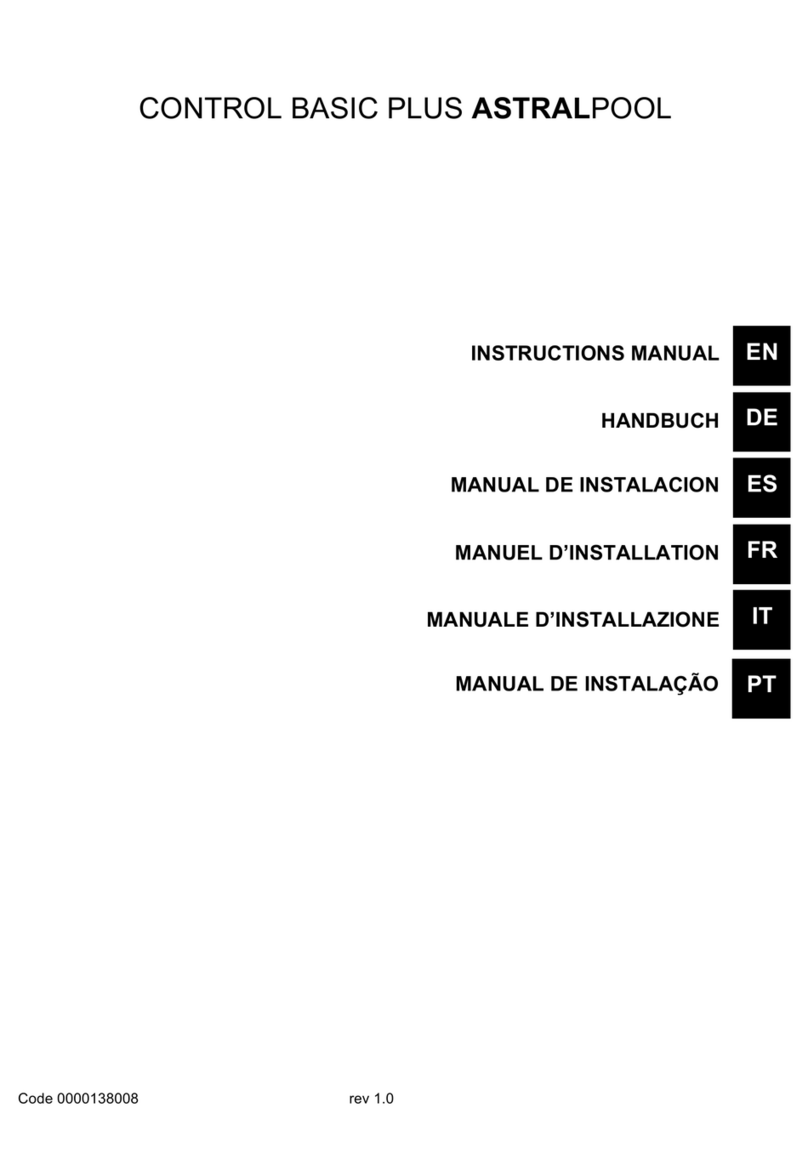
Astral Pool
Astral Pool CONTROL BASIC PLUS installation manual
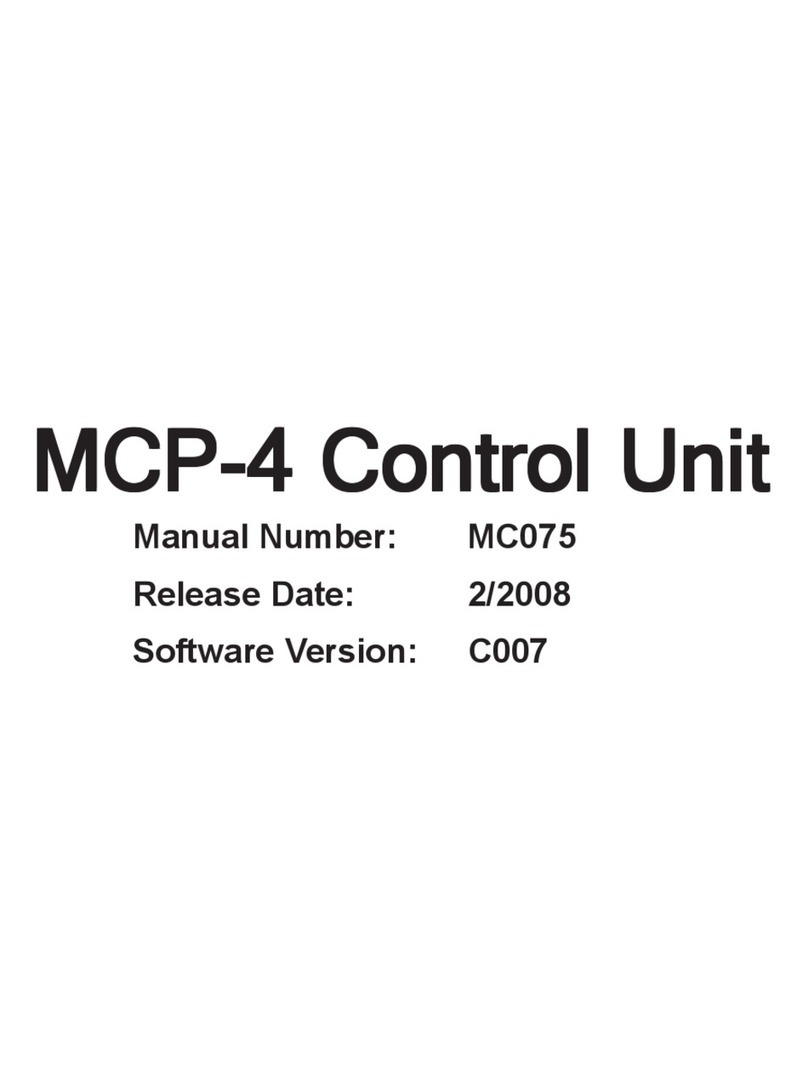
VALCOBABY
VALCOBABY MCP-4 Series manual
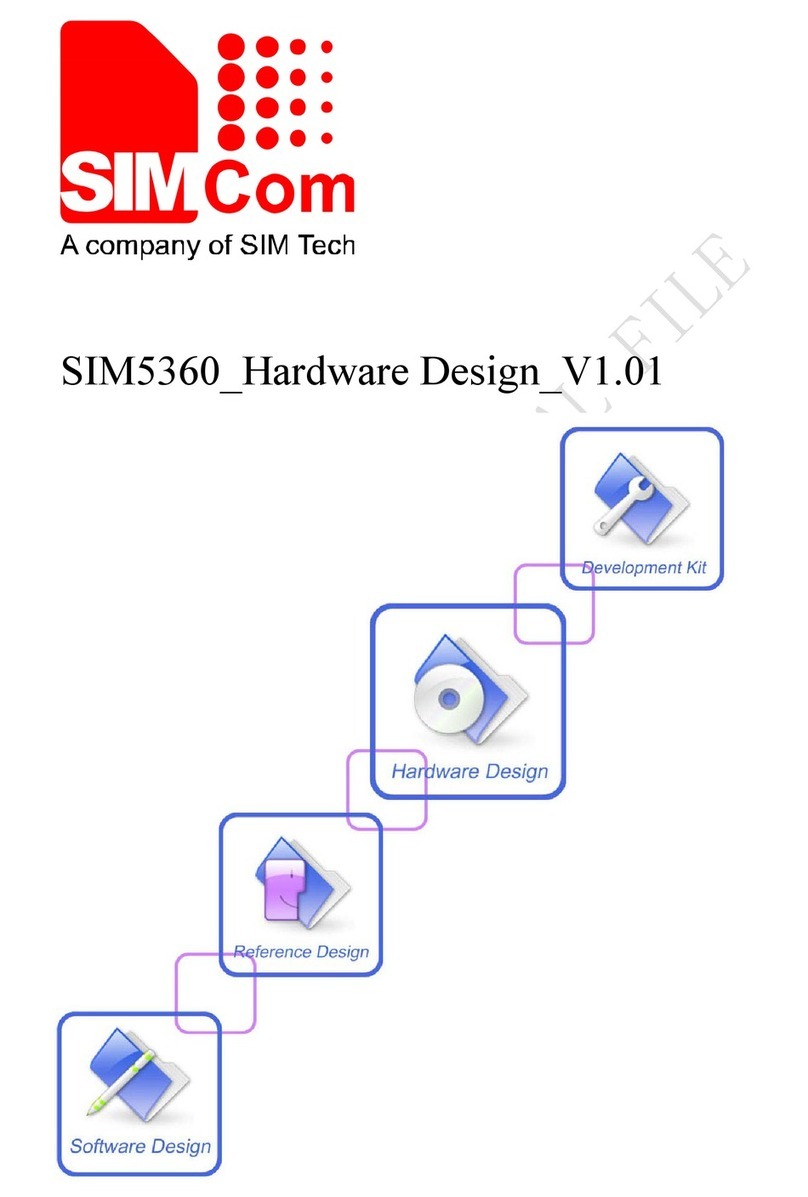
SimTech
SimTech SIMCom SIM5360 Hardware design
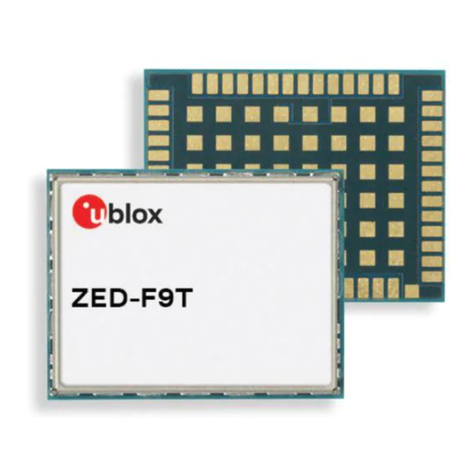
Ublox
Ublox ZED-F9T Integration manual
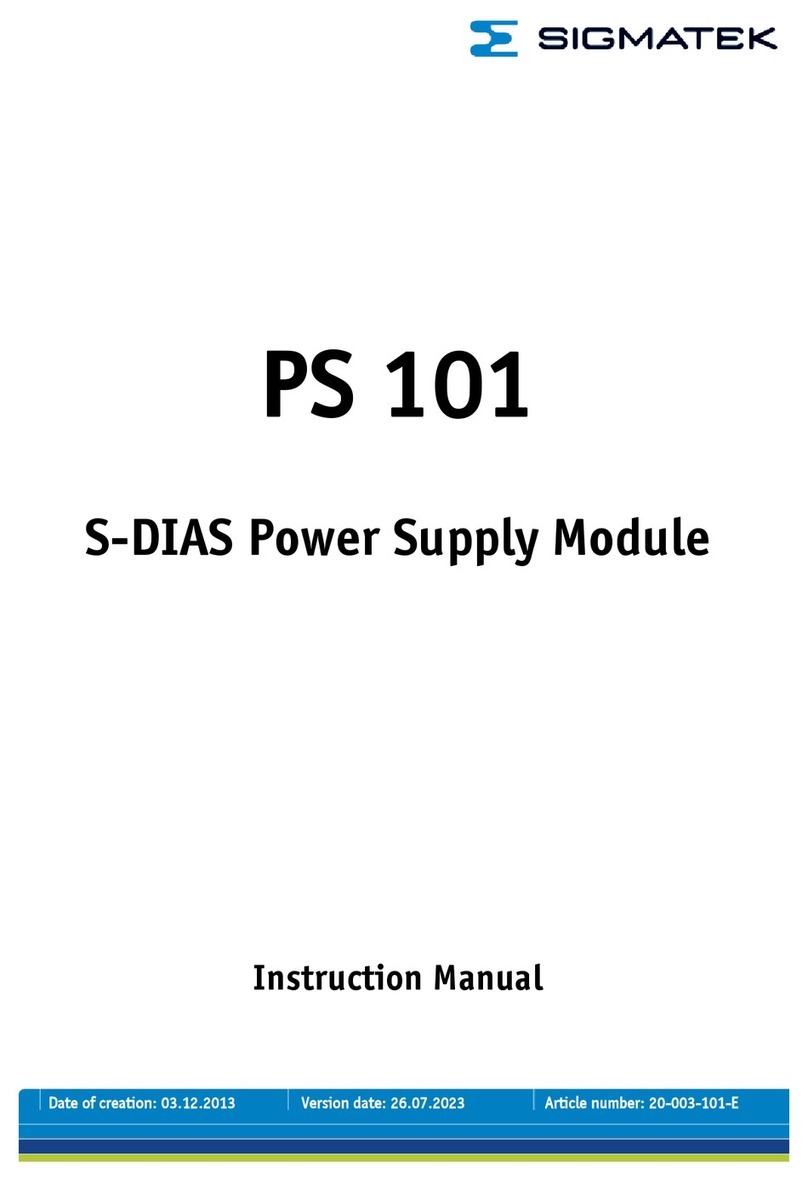
SIGMA TEK
SIGMA TEK S-DIAS PS 101 instruction manual
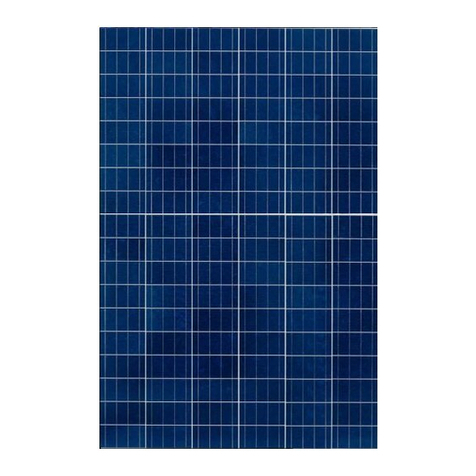
evergreensolar
evergreensolar Spruce Line ES-170 SL Safety, installation, and operation manual
